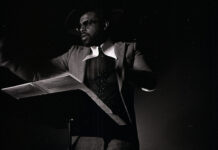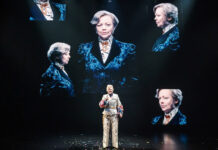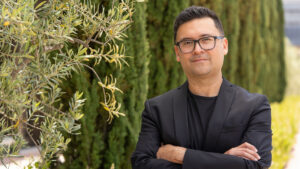
Every performing arts venue likes to advertise what’s new and exciting for their season launch. For CAP UCLA, they truly had a lot to crow about. Their new performing arts space in Westwood, The Nimoy, opened in September. They are also starting the 2023-2024 with their new Executive and Artistic Director Edgar Miramontes. He replaces Kristy Edmunds who left in 2021 for Massachusetts Museum of Contemporary Art. It was Edmunds who first came up with the idea of buying the former Crest Theater in 2018 and turning it into a performing arts venue.
Miramontes, who had previously served as deputy executive director and curator at REDCAT since 2019, inherits a lot of firsts and a lot of challenges. The performing arts haven’t fully recovered from the COVID crisis and audiences haven’t returned in anywhere near the same numbers as before the pandemic. Accessibility in the arts has become a big issue as has representation.
This gave us a lot to talk about when I spoke with Miramontes in mid-October. What follows are excerpts from our conversation that have been edited for length and clarity.
Q: How much does your experience at REDCAT inform what you want to bring to CAP UCLA?
REDCAT was incredibly formative in terms of the kind of artistic, adventurous kind of programing that is the ethos of my own interests and supporting artists. It is, and has been. an artist-centered space. Seeing what artists are doing to say a story a different way using interdisciplinary approaches is something that I’m still interested quite a bit to think about.
CAP UCLA is a larger platform for the kinds of work, just given the size of the stage and the limitations and the types of spaces that CAP UCLA has. So to think about the kind of ethos for me to develop artists from just out of school and into kind of their professional careers, that continues to interest me. The more artists stay in Los Angeles, the better.
Is there more pressure to be successful at CAP UCLA than there was at REDCAT? Are the standards of what defines success different between the two venues?
It depends, really, how one defines success. There’s a lot of incredible support that the School of Arts and Architecture, which is where CAP UCLA sits under, for me and my ideas thinking about how a public institution has a responsibility to expand and serve different publics. Including, of course, the the L.A. area and beyond.
With The Nimoy in particular, I think it does offer additional support towards that vision. I’m quite excited to think about The Nimoy as a pilot for how a center for art and creation and for artists can be utilized to think broadly about the arts and culture that UCLA as a system can affect.
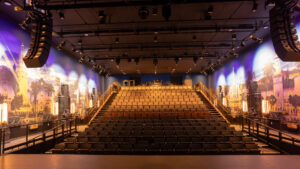
The biggest challenge every arts institution faces right now is getting people back into the theater. One argument that I’ve made for quite some time is that accessibility is a key factor in that. It isn’t just getting beyond COVID. It’s making it accessible to people who can’t afford to pay hundreds of dollars for an evening of theater. What impresses me the most about The Nimoy is that a single person can go see a show and park at The Nimoy for $35.
That’s absolutely right. A lot of that was set up with the wonderful team that I get to work with now. Who comes and parks for $3 in Los Angeles? Tickets are $32, a little less than that.
Accessibility to me is also beyond just tickets. What does it look like to be accessible for others who may have been hearing-impaired? How does one actually think about accessibility as we move forward? As we re-enter these spaces?
I am dealing with the three spaces that we program at CAP UCLA. [Royce Hall, The Theatre at the Ace Hotel, The Nimoy] All historic theaters, all built within a certain time. Physical accessibility was really different. That’s a line of thinking which I’m approaching programing in general to think about what that might look like in terms of accessibility.
What’s the conversation that you and your team has to have with an artist or their representatives that says there’s this theater and it has this price point model and it’s smaller so you’ll probably can fill it? Or there’s this theater that has a broader price point that we can do, but you may not necessarily fill it. What is the power of persuasion that you employ to convince somebody that doing something on a smaller scale may actually be more interesting, more rewarding, if not necessarily more economically rewarding?
I’ve yet to move into those negotiations. I start programing now for the fall of ’24. It’s a lot of leading with the artist’s interests. I’m pursuing work that I think would be able to fit multiple spaces in different ways, but also developing an artist that can work in multiple spaces.
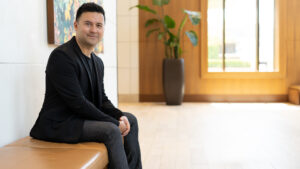
I think artists can find ways to work in multiple ways. With The Nimoy what’s really interesting to me is to think about that you can experiment more. Some of the artists who are working on these larger scale [works] can test out an idea at The Nimoy that then moves potentially into Royce Hall. I think artists are always happy to think about ways of moving their art in a different direction or being pushed to a limitation where limitation becomes the opportunity to think about their work a different way.
You’re obviously establishing a new brand as part of CAP UCLA with The Nimoy. Does that mean that The Nimoy is front and center and takes priority over programing that might take place at the other venues?
Certainly I feel like this is the year of The Nimoy. I think a lot of artists are really curious to see what it can do. It’s a space that CAP UCLA has much more of control over. Royce and ACE are really great partnerships. We can think about The Nimoy as the space for much more development of new work. We can do a lot more with access to it, as ours, in a different way than these other two venues.
We’re having this conversation on the heels of of really horrific events taking place in the Middle East. We’re also doing it on the cusp of an election cycle. What do you think from your personal perspective is the role of the arts in troubled times like these?
If anything, the arts and culture have the power to really to provide multiple perspectives on what is happening. I think it also has the ability to inspire action. I think artists have a history of participating and making work that is directly pointing to, or at least addressing, some of these issues that I think are quite important. I’m interested in thinking quite a bit about the kinds of voices that have not been necessarily at the center and to think about different perspectives that address some of these things.
More and more I find that the work needs to connect what it’s saying and who is saying it to how do you provide an additional platform for conversation to happen right after that. We need artists as leaders, as catalysts, to make work that is entertaining, but also you see something that you’ve never seen before that actually does shift something for you and for those who are experiencing it. On an intellectual level, on an emotional level, but also has a social impact perspective.
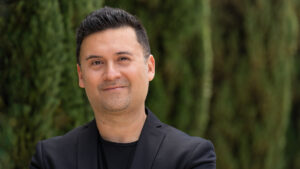
I spoke to Kristy Edmunds in January of 2021. She talked about how she felt like it had been her role to keep artists strong and inspired during the pandemic. I asked her what she did to keep herself strong and inspired. She said, “Artists are finding these places where somehow the glue in the cracks is a kind of kindness and compassion and a willingness to manifest some form of connection. That is ultimately what is going to be what the tail end of this is.”
We don’t know where we are now, but what do you see as the North Star for you in keeping yourself and artists strong and inspired as we move through whatever the next five years is going to throw at us?
I think that we need to think about ourselves as being interconnected to all things. I think that we need to think outside of our silos to be much more like artists: take risks, learn new ideas, research the things that you’re interested in, taking time to see that idea in multiple ways. It means that we need to find ways to redefine collaboration so that it’s, to some degree, less competitive. To think about an ethos of artists, producers, presenters, imagining a new way of working together. Also thinking about what are those values that we can set so that we can build something together. Artists have been doing that for a long time. It’s also leaning in for people who are producers or presenters to think with artistic practice and that means administratively.
I would love to see a festival for two weeks with a vibrancy that you see across the city. That we have multiple connections and in which artists are moving through a different way through these particular spaces. It’s international, it’s local, it’s national; all of these things. And it’s incredibly inclusive. That’s my aspiration of the North Star. But certainly that’s what keeps me going.
Main Photo: The Nimoy Theatre (Photo by Jason Williams/Courtesy CAP UCLA)


